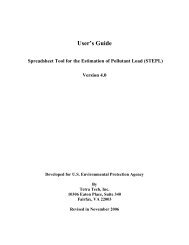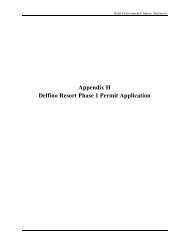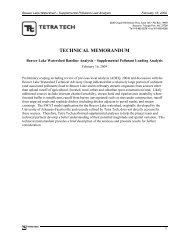SWAT Model Recalibration - Tetratech-ffx.com
SWAT Model Recalibration - Tetratech-ffx.com
SWAT Model Recalibration - Tetratech-ffx.com
- No tags were found...
You also want an ePaper? Increase the reach of your titles
YUMPU automatically turns print PDFs into web optimized ePapers that Google loves.
Beaver Lake <strong>SWAT</strong> <strong>Model</strong>ing Baseline Analysis February 12, 20092 Changes to Improve Hydrologic CalibrationThe version of the <strong>SWAT</strong> model received by Tetra Tech had been partially calibrated only to monthlyflows and generally underestimated total flow volumes and storm peaks. On review, some fundamentalflaws in the model setup, which affect both flow and water quality simulation, were detected and repaired.These include the following:• The first issue noted was the slope length, which describes the maximum distance water travelsbefore reaching a conveyance and forming concentrated flow. It is generally accepted that slopelengths should not exceed about 300 ft. Values of slope length are typically specified bymodeling subwatershed and are automatically generated by the <strong>SWAT</strong> GIS interface, although<strong>SWAT</strong> allows the user to specify these by land use as well. In the modeling input files that TetraTech received, slope lengths were varied primarily by land use and ranged from 0.1 ft to 3,162 ft.Many of the slope lengths specified were outside of normal range; further, the slope length shouldbe determined primarily by topography, not land use. Tetra Tech therefore reverted the model tothe slope lengths determined by the <strong>SWAT</strong> GIS interface.• Management files for agricultural land were malformed so that no fertilization took place,resulting in minimal crop growth and elevated erosion. The autofertilization option was thencorrectly formulated and tested to ensure that normal crop growth occured.• Management files for pervious developed land (lawns) had been set up to simulate continuoussummer growth (no mowing) followed by a harvest operation that removed all residue. Inessence, lawns were simulated as if they were hayed. This resulted in a situation in which therewas no erosion cover throughout the winter and early spring. These management files werereformulated to represent weekly mowing (with most residue left in place) followed by dormancy(rather than harvest) at the end of the growing season.• Management files for pasture land are set up for both fescue and Bermuda grass, the formerrepresenting cool season pasture and the latter warm season pasture. Both had been specifiedwith the same scheduling, resulting in fescue being grazed in the hot, rather than cool season.Bermuda grass grazing was also not consistent with the growth period. Further, harvest wasspecified immediately after grazing, resulting in minimal cover during the winter and spring.These management files were <strong>com</strong>pletely restructured. Fescue is simulated with two (spring andfall) growth periods, while Bermuda grass is now simulated as a warm season crop. Both includeone haying operation with some subsequent regrowth, rather than a single harvest and kill at theend of the growing season.To more accurately predict pollutant loading to the lake, Tetra Tech made additional improvements to thehydrologic simulation which resulted in a better estimate of daily flows. The following modificationswere made:• Decreased the groundwater delay from 31 days to 21 days to match the steeper recession of thebaseflow hydrographs observed at the three USGS stations. This change also resulted in lowerflows simulated in the 50 percent lowest flows category.• Decreased the surface runoff lag time from 12 to 3 days.• Increased the curve numbers for each land use to SCS values so that simulated storm volumes andtotal volumes more closely match those observed at the three USGS gages.• Changed the soil and plant evaporation/transpiration coefficients (ESCO and EPCO) to improvethe simulated seasonal averages and portion of flow allocated to shallow groundwater flow.14





